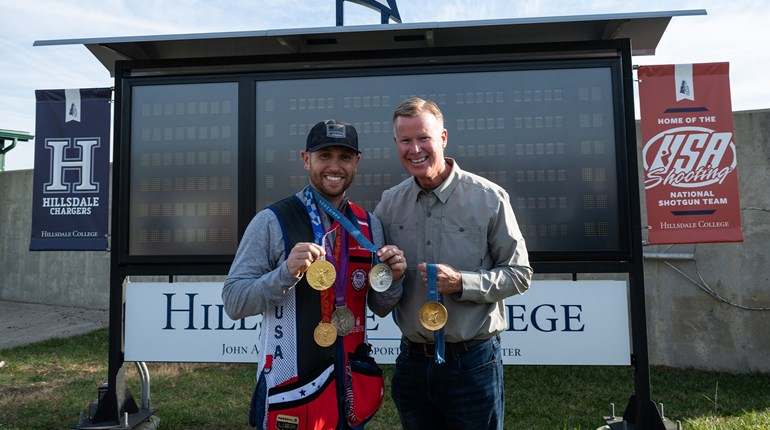
Even if you’re not a serious shotgunner, you’ve probably heard of sporting clays—possibly have even shot a round or two. Sometimes described as “golf with a shotgun,” sporting clays has grown in recent years to become one of the three major American shotgun sports; trap and skeet being the other two.
As with golf, no two sporting clays ranges are alike. Golf courses take advantage of the existing topography on which they’re laid out, and sporting clays courses do the same. But whereas in golf you play either nine or 18 holes, sporting clays has no set number of “holes” or shooting stations. Anywhere from about eight to a dozen shooting stations make up a sporting clays course. A typical round of sporting clays consists of shooting at either 50 or 100 targets, singly or in pairs.
Sporting clays has become so popular because it typifies the many different shots a shotgunner experiences in hunting different game birds. For instance, some targets are thrown away from the shooter, some are incoming, and some fly side to side, high and low. In addition, some sporting clays courses even have “rabbit” targets that roll along the ground on their edge. These can be quite challenging to hit as they bounce along, some targets staying low to the ground as they speed past...while others make high, unexpected jumps or bounces.
The problem with creating and developing a sporting clays course—as least from an ownership perspective—is that a course requires a large amount of land. On top of that, multiple clay-target throwers must be purchased for each shooting station. Obviously, the start-up cost of a sporting clays range can be prohibitively high.
An alternative to a traditional sporting clays course that smaller shooting ranges and sportsmen’s clubs are taking advantage of is a relatively new shotgun game called Five-stand Sporting Clays, or simply Five-stand. In essence, it’s similar to traditional sporting clays, offering shots at targets from a multitude of angles and distances, but does so by placing five shooting stations or stands side-by-side, only a few feet apart.
The advantages of five-stand—again, from a range owner’s standpoint—is that a much smaller parcel of ground is required, possibly as little as only one-tenth of the acreage needed for sporting clays. And fewer clay target machines are needed; just six or eight can throw targets for all five shooting stations.
A typical round of five-stand involves shooting five targets at all five shooting stations, requiring a box of 25 shells to complete the round. Usually, a single target is thrown from each shooting station, followed by two pairs of targets. The pairs may be thrown on-report, as a following-pair, or as a true-pair. On-report means that a second target is thrown as soon as you fire at the first target; in other words, on report of the gun. A following-pair means a second target is thrown automatically a few seconds after the first. And with a true-pair both targets are thrown simultaneously.
For the shooter, there are several advantages to five-stand as compared to sporting clays. As mentioned, a round takes only one box of shells, so the cost of shooting is less. And you can shoot a round of five-stand quickly, usually in only about half an hour’s time even with a full squad of five shooters. But a full squad is not required; a round of five-stand can be shot alone or with just a buddy or two.
Ian Hurd is a professional manager of a five-stand sporting clays range. An accomplished clays shooter and shotgun coach, he’s the sporting clays manager of the sprawling Cardinal Shooting Center (www.thecardinalcenter.com/shooting-center) in central Ohio. The Center offers not only five-stand, but also two sporting clays ranges, a mile-long line of 52 trap fields, 14 skeet fields and 14 rifle and pistol ranges.
“Most of the shotgunners frequenting our ranges still prefer shooting sporting clays over five-stand,” said Hurd. “But some use the five-stand course as a warm-up before shooting the sporting clays courses. They like it because it’s the same type of shots they experience with sporting clays, only in a more condensed space and at a quicker pace.”
Hurd mentioned that a definite advantage for older shooters, and others with mobility issues, is that there is relatively little walking required with five-stand since shooting stations are literally side-by-side. To keep his five-stand course challenging and fresh, Hurd said he tweaks the flight path of targets every couple weeks, and does a full change of the course about once a month.
“The bottom line is that five-stand is similar to sporting clays, only more fast-paced and a little cheaper,” said Hurd. “And although the shots are similar to what you’d typically experience on a sporting clays range, the shooting pace is more like what you’d expect on a trap range. The advantage being that you can shoot more targets in less time. Shotgunners looking for something new should give five-stand a shot.”







































